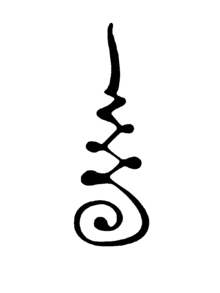
Back Yantra BJN যন্ত্র (চক্র) Bengali/Bangla Yantra Catalan Jantra (hinduismus) Czech Yantra German Jantra (wuchodna religija) DSB Yantra Spanish Yantra Estonian یانترا Persian Yantra Finnish
| Part of a series on |
| Hinduism |
|---|
 |


Yantra (यन्त्र; lit. 'machine'/'contraption'[1]) is a geometrical diagram, mainly from the Tantric traditions of the Indian religions. Yantras are used for the worship of deities in temples or at home; as an aid in meditation; and for the benefits believed given by their occult powers based on Hindu astrology and tantric texts. They are also used for adornment of temple floors, due mainly to their aesthetic and symmetric qualities. Specific yantras are traditionally associated with specific deities and/or certain types of energies used for accomplishment of certain tasks or vows that may be either materialistic or spiritual in nature. They become a prime tool in certain sadhanas performed by the sadhaka, the spiritual seeker. Yantras hold great importance in Hinduism, Jainism, and Buddhism.
Representations of the yantra in India have been considered to date back to 11,000–10,000 BCE.[2] The Baghor stone, found in an upper-Paleolithic context in the Son River Valley, is considered the earliest example[3] by G. R. Sharma, who was involved in the excavation of the stone (it was dated to 25,000–20,000 BCE). The triangular stone, which includes triangular engravings on one side, was found daubed in ochre in what was considered a site related to worship. Worship of goddesses in that region was found to be practiced in a similar manner to the present day.[4] Kenoyer, who was also involved in the excavation, considered it to be associated with Shakti. This triangular shape looks very much similar to Kali Yantra and Muladhara Chakra.[5]
Mantras, the Sanskrit syllables inscribed on yantras, are essentially "thought forms" representing divinities or cosmic powers that exert their influence by means of sound-vibrations.[6]
- ^ "Recent entries into the dictionary". spokensanskrit.de. Archived from the original on February 15, 2017.
- ^ Insoll, Professor of African and Islamic Archaeology Timothy; Insoll, Timothy (2002-09-11). Archaeology and World Religion. Routledge. ISBN 9781134597987.
- ^ Harper, Katherine Anne; Brown, Robert L. (2012-02-01). Roots of Tantra, The. SUNY Press. ISBN 9780791488904.
- ^ "An Archaeologist at Work in African Prehistory and Early Human Studies: Teamwork and Insight". www.oac.cdlib.org. Retrieved 2017-04-11.
- ^ Kenoyer, J. M.; Clark, J. D.; Pal, J. N.; Sharma, G. R. (1983-07-01). "An upper palaeolithic shrine in India?". Antiquity. 57 (220): 88–94. doi:10.1017/S0003598X00055253. ISSN 0003-598X. S2CID 163969200.
- ^ Khanna, Madhu (2003). Yantra: The Tantric Symbol of Cosmic Unity, page 21. Inner Traditions. ISBN 0-89281-132-3 & ISBN 978-0-89281-132-8